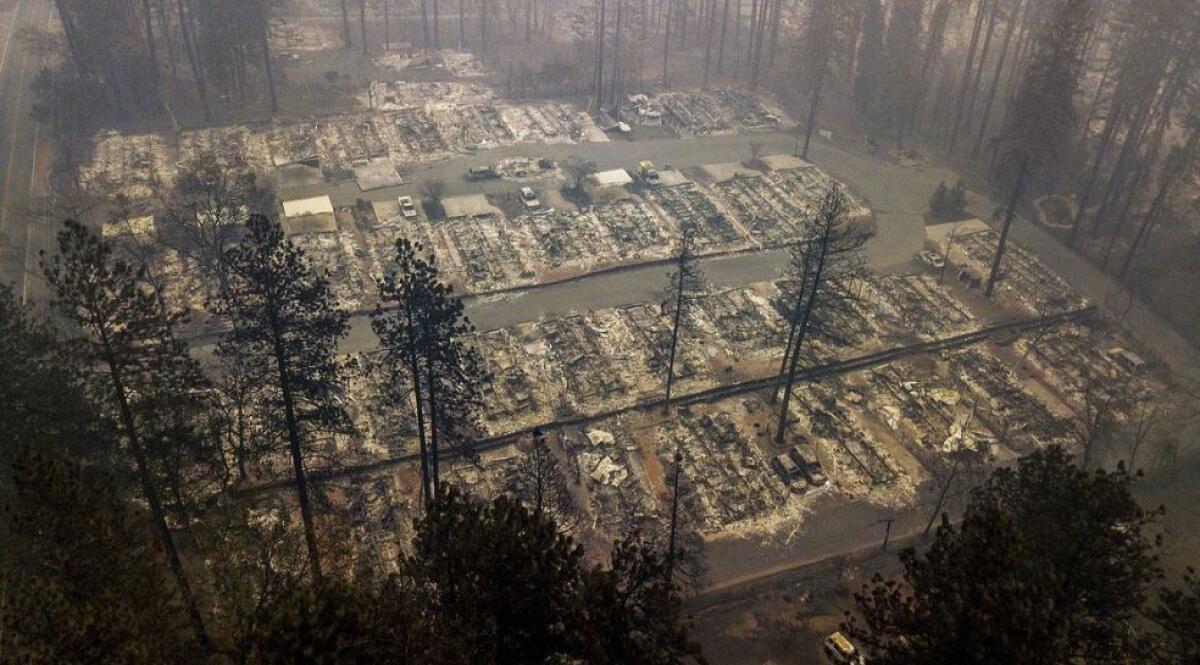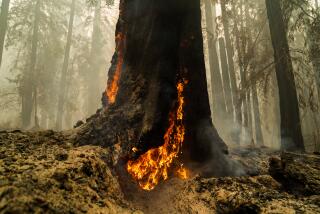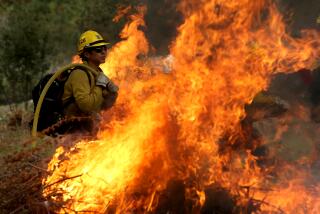Catastrophic fires are a reckoning for Californians and their ‘new normal.’ Has the state reached a tipping point?
In 1860, a young botanist raised in New York and schooled in Connecticut found himself on the payroll of the newly formed California Division of Mines and Geology. His job: Roam the vast, new state, taking samples and observations of plants and animals.
Over four years journeying across California, William Brewer witnessed torrential rains that turned the Central Valley into a vast, white-capped lake; intolerable heat waves that made the “fats of our meats run away in spontaneous gravy;” violent earthquakes; and fires he described as “great sheets of flame, extending over acres.”
He, like explorers, journalists and settlers before him, wondered whether people could permanently settle in California, said David Igler, a professor of history at UC Irvine.
“People were flabbergasted by what was happening,” said Igler, referring to the droughts, floods and quakes of the mid-1800s. “They wondered whether this was a place where we could even really settle and where agriculture could be maintained.”
Since people first migrated across the Bering Sea and down the coast several thousand years ago, the destructive and formidable natural forces that have formed and shaped this state have been chronicled, recorded and woven into the stories, myths and practices of California’s inhabitants.
And with each new wave of arrivals — Native Americans, Spaniards, Russians, American explorers, as well as modern-day transplants and migrants — Californians have striven to adapt to, live with, harness, prevent or subdue the environment, in an ever-evolving, and increasingly tenuous, relationship.
But after this year’s devastating Camp and Woolsey fires, which came on the heels of the landslides in Montecito and Santa Barbara, just months after the Thomas, Tubbs and Atlas fires, it seems a ripe time to ask whether the precarious balance we’ve held onto for so long has finally been lost.
“We’re finally realizing that human-centered activities have played a role in these most recent events, and that human activities are not going to be able to rectify the situation,” said William Deverell, a professor of history at USC. “The genie’s out of the bottle here, and that’s terrible and terrifying.”
Humans, the thinking goes, have so drastically altered the environment at both a global and local scale — with worldwide greenhouse gas emissions, unchecked development, ecosystem damage, forest overgrowth and groundwater and surface water overusage — that we’ve unwittingly bowled ourselves into not just a “new normal,” but a new era increasingly defined by destructive forces.
The question is whether what we’re witnessing now is the latest swing in the evolving human-natural hybrid system we’ve been building since people first arrived — a shift we’ll adjust to, like we always have done before. Or have we truly and finally tipped the scales too far?
Any way you look at the 2018 fire season, it was the most destructive on record. From the number of deaths (104) to the sheer burnt acreage (1,893,913), the devastation was unparalleled — even when compared with 2017, when fires led to 47 deaths and burned 1,381,405 acres. And that was on the heels of the 2007 and 2008 seasons, which were, until 2017, the worst known.
At first glance, it is hard to think someone hasn’t stepped on the gas, propelling our fate off a cliff. Such sentiment, however, is not new.
As far back as California has been recorded in history, its settlers have been living on the edge, ready at any moment to be throttled, beaten, burned, drowned, choked and starved out of existence. Yet, we’re still here, the fifth-largest economy on the planet, the food basket of the nation and the world’s driver of technological innovation.
What these latest events call for, said Jon Christensen, an author and lecturer at UCLA’s Institute of the Environment and Sustainability, is not for us to wring our hands and wonder when the end is coming, but for us to be conscious of our history, our role in shaping our environment, then “figure out how to manage it.”
“This old story line of our decline and fall from paradise, it is one of the oldest stories in the book,” Christensen said. “When you have a story line that old, one that keeps repeating itself every few years, you have to be skeptical.”
Over the years, the perceived cause of the state’s impending doom has shifted — from God, to our shared sin, to climate change and overdevelopment — but the notion we’re living at the edge of existence has remained a constant theme.
Consider 1992 to 1995, when damaging floods, firestorms and the Northridge earthquake pummeled Southern California with 97 deaths and nearly $44 billion in damages. As Los Angeles Times columnist, Peter H. King, wrote in 1995, “There’s no question California is caught in the middle of something strange… maybe God, as the biblical sorts preach, is mad at us for making all those dirty movies.”
In “Ecology of Fear,” Mike Davis’ 1998 book about the culture of disaster in Los Angeles, he pondered whether the cluster of disaster was “coincidental or eschatological.” In other words, a statistical anomaly, or the arrival of the Apocalypse.
As he and others noted, the idea of disaster was largely built upon a northern European and East Coast American environmental framework that suggests normality means predictability — with the same amount of rain or snow falling every year and roughly the same temperature variation every season.
“Normal implies a constant or some stability,” said Christensen, the UCLA historian. “What is definable in California is variability. The average here is meaningless.”
And for thousands of years, the first settlers understood that, successfully adapting to the mercurial environment by living in small groups of 500 to 1,000 people and moving seasonally within tribal boundaries to forage and hunt where food was plentiful, said Steven Hackel, a professor of history at UC Riverside and author of “Children of Coyote, Missionaries of Saint Francis.”
They also managed the land with small, prescribed burns — estimates suggest 15% of California was burned every year — to harvest, seed and stimulate the growth of grasses, acorns, berries and environments conducive for hunting quail and deer, Hackel said.
“They used fire in the same way we use dams and aqueducts,” he said. “They were intentionally and skillfully managing the land.”
And as Christensen noted, they were creating a hybrid landscape as much formed by nature as human hands.
When the Spanish arrived, they outlawed fire, Hackel said, and soon the California environment morphed again. They diverted rivers and snowmelt to saturate and irrigate farms. And they wiped out the native flora via widespread cattle and sheep grazing, replacing it with hardier, nonnative weed species.
As American settlers followed from eastern and Midwestern states, they left their own footprint: Cities, aqueducts, dams, reservoirs, roads, railroads and bridges built for earthquakes, droughts, and floods.
But as our population has exploded, roughly doubling every 10 years, we’re now pushing into landscapes and areas we haven’t lived before, and as a result, experts are beginning to wonder if we’re losing our grip on the human-nature chimera we created. Especially if you throw climate change into the mix, Christensen said.
“It sometimes feels like we take two steps forward and one step back,” he said. “Actually, maybe more like one step forward two steps back.”
But fire historians and experts, such as Scott Stephens, co-director of the Center for Fire Research and Outreach at UC Berkeley, are certain we can face this challenge, like we have others.
“We can change the trajectory,” he said. “We just have to change our M.O.”
Prescribed burns, brush removal, fire-resistant building materials and codes, as well as local and rural fire education can all help to reduce the catastrophic effects of fires, said Stephens and Stephen Pyne, a native Californian and professor of history at Arizona State University.
For too long, “we’ve been tinkering at the edges” of fire policy and management, said Pyne, but “not changing the fundamentals” that could prevent the disasters we have seen in the last few years.

But it will take political will, he said, and hard decisions and choices that many will not like.
“California is built to burn,” Pyne said. “If we left tonight, it’d still burn tomorrow and would burn all the way to the Pacific. It’s always burned. It’s just that the whole process of colonization really upended the balance that had happened before.”
And while Pyne, Stephens and Christensen see solutions and adaptations that can be made to avert destructive conflagrations, they, and others, voiced concern about our political will and the possibility that choices made beyond state boundaries will send us on a trajectory we’ve never witnessed before.
“I think we have to reach a tipping point,” Pyne said. If we don’t, “I worry we’ll treat these mass burnings like we treat mass shootings. We’ll think about it for a day, and then move on. Not really addressing it.”
Others worry that despite California’s leadership in environmental policy, disaster response and technological savvy, the problem may now be beyond our control. All the policies we establish to limit our own climate footprint will have little effect on this new, runaway environment if the rest of the world chooses to continue burning fossil fuels.
“Hopefully, we’ll lead the rest of the world on this issue as we have done on so many others,” Hackel said. “It’s a vexing question.”
Yet, if we can take any comfort from the voices of our past, as William Brewer noted as he watched Californians rebuild their cities and towns after the Great Flood of 1862, there are “no people (who) can so stand calamity as this people,” he said. “They are used to it.”
Twitter: @susrust
More to Read
Start your day right
Sign up for Essential California for news, features and recommendations from the L.A. Times and beyond in your inbox six days a week.
You may occasionally receive promotional content from the Los Angeles Times.







